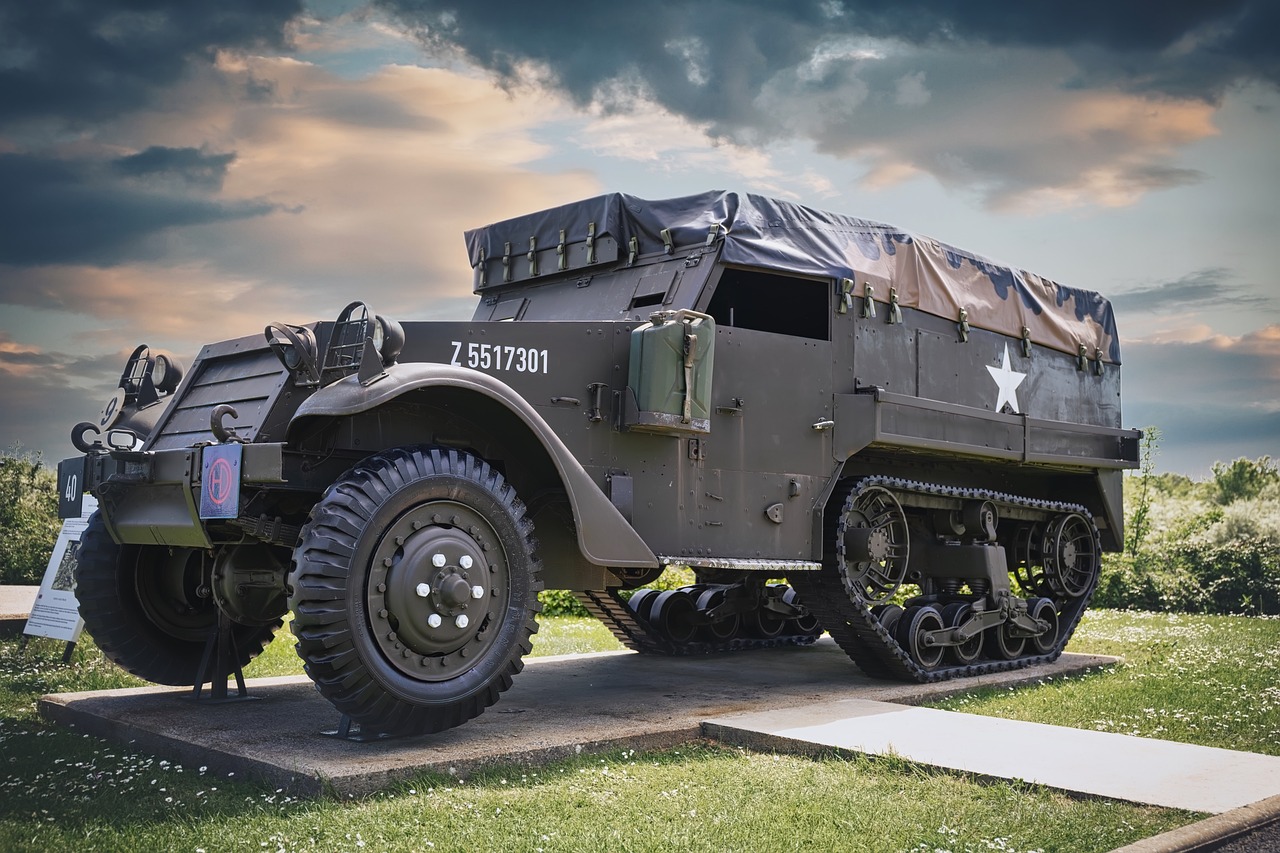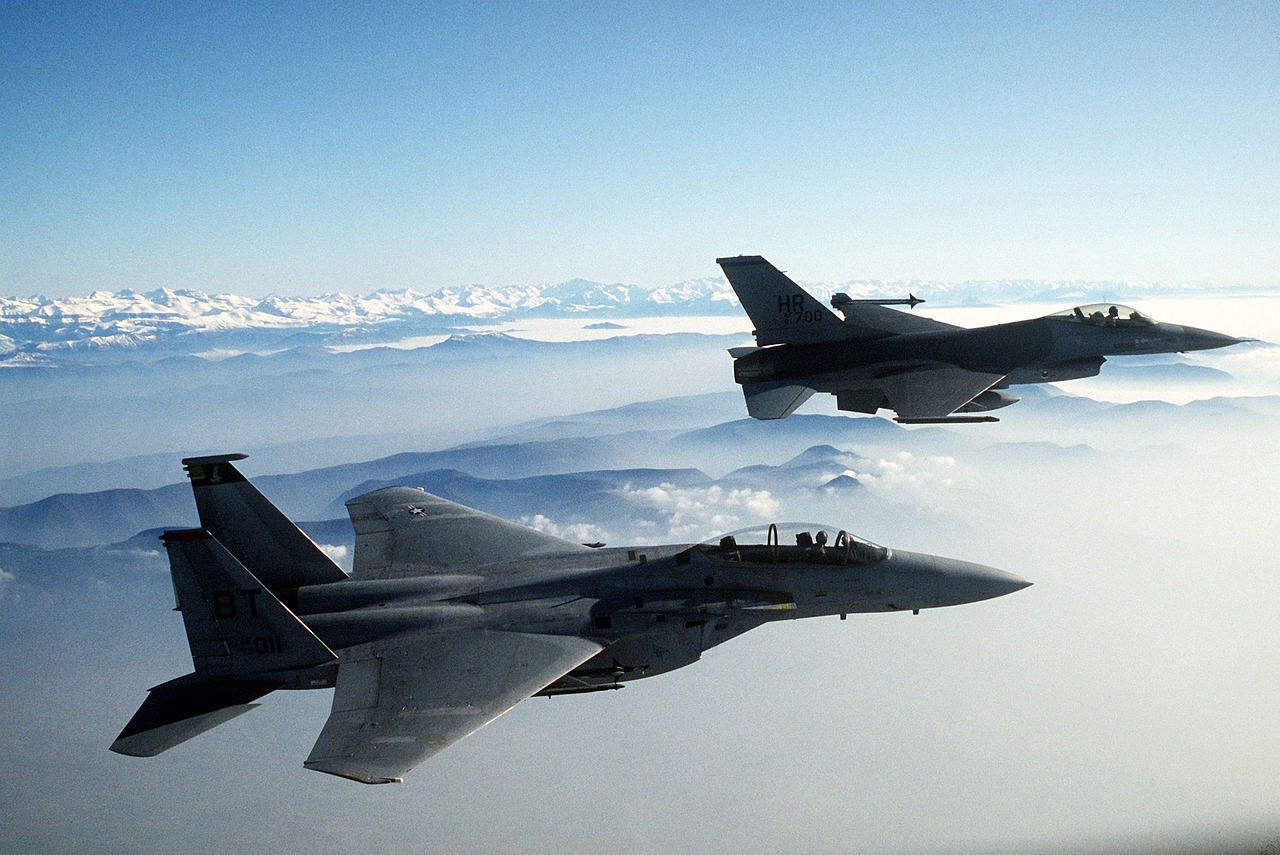The Impact of Big Data on Military Operations
Big data is revolutionizing the way military operations are conducted across the globe. In an age where information is as valuable as weaponry, the ability to harness vast amounts of data can be the difference between victory and defeat. Imagine a battlefield where every decision is backed by real-time data analysis, predictive models, and advanced visualization techniques. This is not science fiction; it’s the reality of modern warfare. The integration of big data into military strategies enhances decision-making processes, improves operational efficiency, and ultimately saves lives. But what exactly is big data, and how does it influence military operations?
Big data refers to the enormous volumes of structured and unstructured data generated every second across various platforms. In the military context, this data can come from numerous sources, including satellite imagery, drone surveillance, social media, and even sensor data from vehicles and equipment. The ability to process and analyze this data is crucial for military operations. Technologies such as machine learning, artificial intelligence, and cloud computing play a significant role in managing this information overload. By leveraging these technologies, military leaders can gain insights that were previously unimaginable, allowing them to make informed decisions swiftly.
One of the most significant advantages of big data analytics is its ability to empower military leaders to make informed decisions quickly. In complex and rapidly changing environments, having access to accurate and timely information can enhance situational awareness and operational planning. For instance, during a conflict, commanders can utilize big data to analyze troop movements, predict enemy actions, and optimize resource allocation. This data-driven approach not only improves the effectiveness of military strategies but also minimizes risks to personnel.
The capability to analyze data in real-time is crucial for military success. Technologies such as advanced algorithms and data processing tools enable military personnel to interpret vast amounts of information almost instantaneously. Imagine a scenario where a drone captures live footage of enemy positions; with real-time data analysis, commanders can adjust their strategies on the fly, responding to threats as they develop. This immediacy can significantly impact tactical operations, giving the military a strategic edge.
Predictive analytics is another powerful tool in the military’s arsenal. By analyzing historical data, military strategists can forecast potential future outcomes. For example, understanding past enemy movements allows commanders to anticipate their next steps and prepare accordingly. This proactive approach can lead to better resource allocation, ensuring that troops are in the right place at the right time. The ability to predict actions before they happen is akin to having a crystal ball, providing a significant advantage in military operations.
Effective data visualization is essential for comprehending complex information. Military personnel often deal with vast amounts of data that can be overwhelming. Tools that enhance data interpretation, such as heat maps, graphs, and interactive dashboards, allow military leaders to visualize trends and patterns quickly. By translating raw data into accessible formats, these techniques facilitate better understanding and communication among team members, ultimately leading to more informed decisions.
The Internet of Things (IoT) is significantly contributing to the big data landscape in military contexts. With interconnected devices gathering and sharing critical information, the military can create a comprehensive operational picture. Sensors embedded in vehicles, equipment, and even personnel can relay data in real-time, providing insights that can be crucial during missions. This integration of IoT and big data not only enhances situational awareness but also streamlines communication across various units, making operations more efficient.
Despite its numerous advantages, big data presents challenges that military operations must address. Issues such as data security and privacy concerns are paramount. As military forces increasingly rely on data, protecting sensitive information from cyber threats becomes critical. Furthermore, the ethical implications of surveillance and data collection raise questions about the balance between operational effectiveness and individual rights. Addressing these challenges is essential for the responsible use of big data in military contexts.
Protecting military data from cyber threats is of utmost importance. As technology evolves, so do the tactics used by those who wish to exploit vulnerabilities. Current vulnerabilities must be identified and addressed through robust cybersecurity measures. Strategies such as encryption, multi-factor authentication, and continuous monitoring can help safeguard sensitive information. The military must stay one step ahead to ensure that their data remains secure and operational integrity is maintained.
The use of big data in military operations raises ethical questions regarding surveillance and privacy. As military forces gather vast amounts of data, there is a fine line between ensuring national security and infringing on individual rights. It is crucial to explore how to balance operational effectiveness with ethical considerations, ensuring that the use of data is both effective and responsible.
As technology continues to evolve, so will the applications of big data in military operations. Future trends may include advancements in artificial intelligence, machine learning, and even quantum computing, all of which could further enhance data processing capabilities. Innovations in data analytics will likely lead to more sophisticated predictive models and improved decision-making processes. The military must remain adaptable and forward-thinking to leverage these advancements effectively.
- What is big data in the military? Big data refers to the vast amounts of structured and unstructured data generated from various sources, including surveillance, satellite imagery, and sensor data.
- How does big data enhance decision-making in military operations? Big data analytics provides military leaders with real-time insights, improving situational awareness and enabling informed decisions quickly.
- What are the challenges of using big data in the military? Challenges include data security concerns, ethical considerations regarding surveillance, and the need for robust cybersecurity measures.
- What role does IoT play in military big data? IoT devices collect and share critical information, enhancing situational awareness and streamlining communication among units.

Understanding Big Data in the Military
Big data is not just a buzzword; it’s a game-changer in the realm of military operations. Imagine a vast ocean of information, where every wave represents data generated from various sources, including satellite imagery, sensor readings, communication logs, and even social media interactions. This data can be structured, like databases that are easily searchable, or unstructured, like the myriad of conversations happening online. The significance of big data in the military cannot be overstated, as it plays a critical role in enhancing operational effectiveness and strategic planning.
The military's ability to harness big data hinges on several key technologies. These include advanced analytics, cloud computing, artificial intelligence, and machine learning. Each of these technologies contributes to the military's capability to process and analyze massive datasets quickly and efficiently. For example, cloud computing allows for scalable storage solutions, while artificial intelligence can sift through data at lightning speed, identifying patterns and insights that would take humans much longer to discern.
One of the most fascinating aspects of big data in the military is its application in real-time scenarios. When troops are deployed, having immediate access to relevant data can mean the difference between success and failure. This is where technologies like satellite communications and drones come into play, providing real-time information that can be analyzed on the fly. The integration of these technologies ensures that military leaders can make informed decisions based on the freshest data available.
Moreover, big data is not just about collecting information; it’s about connecting the dots. For instance, by analyzing historical data alongside current intelligence, military strategists can identify trends and predict potential threats. This predictive capability is invaluable, allowing for proactive measures rather than reactive responses. In essence, big data transforms raw information into actionable intelligence, which is crucial for mission success.
To illustrate the impact of big data, consider the following table that outlines some of the key applications within military operations:
| Application | Description |
|---|---|
| Intelligence Gathering | Collecting and analyzing data from various sources to inform military strategy. |
| Operational Planning | Using data analytics to optimize resource allocation and mission planning. |
| Threat Assessment | Analyzing patterns in data to identify potential threats before they materialize. |
| Logistics Management | Enhancing supply chain efficiency through data-driven insights. |
In conclusion, understanding big data in the military is about recognizing its transformative potential. As the military continues to evolve, the integration of big data technologies will undoubtedly enhance decision-making processes, improve operational efficiency, and ultimately lead to greater success on the battlefield. The future of military operations will be dictated not just by the weapons they wield, but by the intelligence they gather and analyze.
- What is big data in the military? Big data in the military refers to the vast amounts of structured and unstructured data that are generated and analyzed to enhance operational effectiveness and strategic planning.
- How does big data improve decision-making? Big data improves decision-making by providing real-time insights and predictive analytics, allowing military leaders to make informed choices based on the latest information.
- What technologies are involved in military big data? Key technologies include cloud computing, artificial intelligence, machine learning, and advanced analytics, which help process and analyze large datasets efficiently.
- What are the challenges of using big data in the military? Challenges include data security concerns, ethical considerations regarding surveillance, and the need for robust cybersecurity measures to protect sensitive information.

Enhanced Decision-Making
In today's fast-paced military landscape, big data analytics has emerged as a game-changer for decision-making processes. Imagine a battlefield where every move is guided by real-time data—this is no longer science fiction; it's the reality for modern armed forces. With the ability to process vast amounts of information, military leaders can now make informed decisions at lightning speed, significantly enhancing their operational effectiveness. The integration of data-driven insights into military strategies has transformed how commanders assess situations, allocate resources, and plan operations.
One of the most compelling aspects of big data in military operations is its ability to improve situational awareness. This is crucial in complex environments where every second counts. By leveraging advanced analytics, commanders can quickly evaluate the dynamics of a situation, such as troop movements, enemy positions, and environmental factors. This capability not only allows for a more comprehensive understanding of the battlefield but also enables military leaders to anticipate potential threats and react accordingly.
Furthermore, big data analytics facilitates operational planning by providing insights that were previously unimaginable. For instance, consider the following:
- Resource Allocation: By analyzing historical data and current trends, military strategists can optimize the deployment of personnel and equipment.
- Risk Assessment: Data-driven models help identify high-risk areas, allowing for more strategic planning and resource distribution.
- Mission Planning: With predictive analytics, commanders can simulate various scenarios, helping them to prepare for multiple contingencies.
This enhanced decision-making capability is further supported by real-time data analysis. The military employs cutting-edge technologies that enable immediate data processing, which is vital during operations. For example, the use of drones equipped with sensors can provide live feeds of battlefield conditions, allowing commanders to make split-second decisions based on the most current information available.
The advent of technologies such as artificial intelligence (AI), machine learning, and advanced sensor networks plays a pivotal role in real-time data analysis. These technologies allow for the rapid collection and processing of information from various sources, including satellites, reconnaissance missions, and on-ground personnel. The impact of this immediate data processing on tactical operations cannot be overstated; it essentially allows military forces to stay one step ahead of their adversaries.
Another fascinating aspect of big data in military operations is the use of predictive analytics. By harnessing historical data, military leaders can forecast future outcomes with remarkable accuracy. This capability is invaluable when it comes to anticipating enemy movements and optimizing resource allocation. For instance, if historical data indicates a pattern of enemy attacks during certain times or conditions, military planners can adjust their strategies accordingly, ensuring that they are prepared for potential threats.
As the saying goes, "a picture is worth a thousand words," and this rings especially true in military operations. Effective data visualization techniques are essential for comprehending complex information. Tools like heat maps, 3D terrain models, and interactive dashboards enable military personnel to visualize data in a way that enhances understanding and facilitates quicker decision-making. By presenting data in a clear and engaging manner, commanders can grasp critical insights without getting lost in a sea of numbers.
In summary, the integration of big data analytics into military operations has revolutionized decision-making processes. The ability to analyze vast amounts of information in real-time, coupled with predictive analytics and effective data visualization, equips military leaders with the tools they need to navigate the complexities of modern warfare. As we move forward, the role of big data in enhancing decision-making will only continue to grow, ensuring that armed forces remain agile, informed, and ready to respond to any challenge.
- What is big data in the military context? Big data refers to the immense volume of structured and unstructured data that military organizations generate and analyze to improve operational efficiency and decision-making.
- How does big data enhance decision-making? By providing real-time insights, predictive analytics, and effective data visualization, big data empowers military leaders to make informed decisions swiftly and accurately.
- What technologies are involved in big data analytics? Key technologies include artificial intelligence, machine learning, advanced sensors, and data visualization tools that enable the collection and analysis of vast amounts of data.
- What challenges does big data present for military operations? Challenges include data security concerns, privacy issues, and the ethical implications of surveillance, which require careful consideration and strategic planning.

Real-Time Data Analysis
In today's fast-paced military landscape, has emerged as a game-changer. Imagine being in a high-stakes chess match where every second counts; that’s what military operations are like. The ability to process and analyze data instantaneously can mean the difference between success and failure on the battlefield. With advancements in technology, military forces can now leverage real-time data to enhance their situational awareness and operational effectiveness.
One of the primary technologies enabling this rapid analysis is artificial intelligence (AI). AI algorithms can sift through massive datasets, identifying patterns and anomalies that human analysts might miss. This capability allows military leaders to respond to threats more swiftly and accurately. For instance, during a mission, AI can analyze incoming intelligence reports, satellite imagery, and social media feeds to provide a comprehensive view of the operational environment.
Moreover, the integration of cloud computing plays a crucial role in real-time data analysis. By utilizing cloud infrastructure, military units can access and share data seamlessly across various platforms. This connectivity ensures that all team members, whether in the field or at headquarters, have access to the same up-to-date information. This level of collaboration is vital when every moment counts, and decisions need to be made rapidly.
To illustrate the impact of real-time data analysis on military operations, consider the following table:
| Technology | Function | Impact on Military Operations |
|---|---|---|
| Artificial Intelligence | Data processing and pattern recognition | Faster decision-making and threat identification |
| Cloud Computing | Data storage and sharing | Enhanced collaboration and operational efficiency |
| Advanced Sensors | Real-time data collection | Improved situational awareness and responsiveness |
Additionally, advanced sensors play a pivotal role in gathering real-time data. These sensors, deployed on drones, satellites, and ground vehicles, continuously collect information about the battlefield environment. This data is then transmitted to command centers for analysis, allowing military leaders to make informed decisions based on the most current information available. Think of it as having a 360-degree view of a complex situation, enabling commanders to anticipate movements and react accordingly.
However, the implementation of real-time data analysis is not without its challenges. The sheer volume of data generated can be overwhelming. Military forces must ensure they have the right tools and trained personnel to interpret this data effectively. Without proper training and resources, the potential of real-time data can be underutilized, leading to missed opportunities and critical errors.
In conclusion, real-time data analysis is revolutionizing military operations. By harnessing the power of AI, cloud computing, and advanced sensors, military leaders can enhance their decision-making processes and operational efficiency. As technology continues to evolve, we can expect even more innovative solutions to emerge, further solidifying the role of real-time data analysis in modern warfare.
- What is real-time data analysis in the military?
It refers to the immediate processing and interpretation of data to make quick and informed decisions during military operations. - How does artificial intelligence contribute to real-time data analysis?
AI algorithms can analyze vast amounts of data rapidly, identifying patterns and providing actionable insights for military leaders. - What are the challenges of implementing real-time data analysis?
The challenges include managing the volume of data, ensuring proper training for personnel, and maintaining data security.

Predictive Analytics
Predictive analytics is a game changer in the realm of military operations, leveraging historical data to forecast future events and trends. Imagine being able to anticipate enemy movements or potential threats before they even materialize. This is the power of predictive analytics, which allows military leaders to make proactive decisions rather than reactive ones. By analyzing vast amounts of data, military strategists can identify patterns and correlations that would otherwise go unnoticed. This capability transforms the way operations are planned and executed, making them not only more efficient but also significantly more effective.
One of the most compelling aspects of predictive analytics is its ability to optimize resource allocation. For instance, when deploying troops or equipment, knowing where and when to send them can mean the difference between success and failure. By utilizing predictive models, military planners can assess various scenarios and allocate resources accordingly. This means that rather than sending units into uncertain situations, they can focus on areas where they are most likely to succeed, thereby conserving resources and minimizing risks.
Moreover, predictive analytics plays a crucial role in enhancing situational awareness. In modern warfare, the battlefield is often chaotic and unpredictable. Having access to predictive insights allows commanders to maintain a clearer picture of the operational environment. They can anticipate enemy actions, identify potential ambush points, and even predict the likelihood of civilian presence in certain areas. This level of foresight is invaluable in making informed decisions that can save lives and achieve mission objectives.
To illustrate the effectiveness of predictive analytics, consider the following table that outlines its applications in military contexts:
| Application | Description | Impact |
|---|---|---|
| Anticipating Enemy Movements | Using historical data to predict where enemy forces are likely to move. | Improved tactical planning and reduced surprise attacks. |
| Resource Allocation | Forecasting the need for troops and equipment in various scenarios. | Enhanced efficiency and reduced wastage of military assets. |
| Threat Assessment | Evaluating potential threats based on data trends. | Better preparedness and response strategies. |
In conclusion, predictive analytics not only enhances decision-making but also provides a strategic advantage in military operations. As technology continues to evolve, the integration of more sophisticated algorithms and machine learning techniques will further refine these predictive capabilities, allowing military forces to stay one step ahead of their adversaries. In a world where uncertainty is a constant, being able to predict the unpredictable is not just a luxury; it’s a necessity.
- What is predictive analytics in the military? Predictive analytics involves using historical data and statistical algorithms to forecast future outcomes, thereby aiding military decision-making.
- How does predictive analytics improve operational efficiency? It helps in anticipating enemy movements and optimizing resource allocation, allowing for better planning and execution of military strategies.
- What technologies are used for predictive analytics? Technologies such as machine learning, data mining, and statistical modeling are commonly employed to analyze large datasets in military contexts.
- Are there any risks associated with predictive analytics? Yes, while it provides significant advantages, there are concerns regarding data privacy, security, and the potential for erroneous predictions leading to misguided decisions.

Data Visualization Techniques
In the realm of military operations, have emerged as a pivotal tool for transforming complex data sets into understandable and actionable insights. Imagine trying to decipher a massive jigsaw puzzle where each piece represents a different data point. Without the right visualization techniques, it can feel overwhelming and chaotic. But when you start to see those pieces come together, the bigger picture becomes clear, and that’s where the power of data visualization shines.
One of the most effective techniques used in military contexts is geospatial visualization. This approach allows military planners to visualize data on maps, integrating various layers of information such as troop movements, terrain features, and enemy positions. By presenting data spatially, commanders can quickly assess situations and make informed decisions. For example, a heat map illustrating areas of high enemy activity can guide strategic deployments and resource allocation.
Another key technique is dashboards, which consolidate multiple data sources into a single, interactive interface. These dashboards can display real-time statistics, operational metrics, and alerts, providing military leaders with a comprehensive overview of ongoing operations. Think of it as a cockpit for military operations, where every vital piece of information is at the commander’s fingertips, allowing for swift and effective decision-making.
To further enhance understanding, infographics are often employed to simplify complex data narratives. These visual representations can convey trends, comparisons, and relationships in a digestible format. For instance, an infographic illustrating the success rates of various strategies over time can help military analysts identify the most effective tactics. By translating data into visually appealing formats, information becomes more accessible and easier to communicate across different levels of command.
Moreover, data visualization tools such as Tableau, Power BI, and ArcGIS are increasingly being adopted within military organizations. These tools enable personnel to create dynamic visualizations that can be manipulated in real-time, allowing for deeper exploration of data. With these technologies, military analysts can drill down into specific data points, uncovering insights that might otherwise remain hidden in raw data.
In conclusion, the integration of in military operations not only enhances situational awareness but also fosters improved communication and collaboration among team members. By transforming complex data into clear visual narratives, military leaders can navigate the intricacies of modern warfare with greater efficiency and effectiveness. As technology continues to evolve, we can expect these visualization techniques to become even more sophisticated, further empowering military forces to make data-driven decisions.
- What are data visualization techniques?
Data visualization techniques are methods used to represent data graphically, making complex information easier to understand and analyze.
- Why are data visualization techniques important in military operations?
They help military leaders quickly grasp complex situations, enhance decision-making, and improve communication among team members.
- What tools are commonly used for data visualization in the military?
Popular tools include Tableau, Power BI, and ArcGIS, which allow for the creation of interactive and dynamic visualizations.
- How does geospatial visualization benefit military planning?
It provides a spatial context to data, allowing commanders to visualize troop movements and enemy positions on maps, facilitating strategic decision-making.

Integration of IoT and Big Data
The integration of the Internet of Things (IoT) with big data is revolutionizing military operations in ways that were once thought to be the stuff of science fiction. Imagine a battlefield where every piece of equipment, from drones to tanks, is interconnected and capable of sharing real-time data. This synergy not only enhances operational efficiency but also provides military leaders with unprecedented situational awareness. With IoT devices continuously collecting data, the military can analyze vast amounts of information to make informed decisions.
One of the most significant advantages of this integration is the ability to gather data from various sources, such as sensors embedded in equipment, surveillance drones, and even wearable devices on soldiers. This data can provide insights into everything from troop movements to equipment status, allowing commanders to respond rapidly to changing conditions on the ground. For instance, a network of sensors can monitor environmental conditions, providing crucial information that affects tactical decisions. The real-time analysis of this data enables military forces to maintain a tactical edge in complex environments.
Furthermore, the integration of IoT and big data leads to improved resource allocation. By analyzing data from various sources, military leaders can optimize the deployment of assets, ensuring that resources are used efficiently. For example, data analytics can help determine the best locations for troop deployments based on historical data and predictive modeling. This ability to anticipate needs before they arise can significantly enhance operational effectiveness.
However, the power of IoT and big data comes with its challenges. The sheer volume of data generated can be overwhelming, requiring sophisticated algorithms and machine learning techniques to extract meaningful insights. Additionally, the interconnected nature of IoT devices raises concerns about vulnerabilities to cyberattacks. Protecting sensitive military data is paramount, and strategies must be developed to safeguard against potential breaches.
In summary, the integration of IoT and big data is transforming military operations by providing real-time insights, enhancing situational awareness, and improving resource allocation. As technology continues to advance, we can expect to see even more innovative applications of these technologies in defense strategies.
- What is IoT in the military context?
IoT refers to interconnected devices that communicate and share data, enhancing operational efficiency and situational awareness in military operations.
- How does big data improve military decision-making?
Big data analytics allows military leaders to quickly analyze vast amounts of information, leading to informed decisions based on real-time insights.
- What are the security concerns with IoT in the military?
The interconnected nature of IoT devices makes them vulnerable to cyberattacks, necessitating robust cybersecurity measures to protect sensitive data.
- Can predictive analytics be used in military operations?
Yes, predictive analytics utilizes historical data to forecast future outcomes, helping military leaders anticipate enemy movements and optimize resource allocation.

Challenges of Big Data in Military Operations
While the potential of big data in military operations is undeniably transformative, it comes with its own set of challenges that cannot be overlooked. The sheer volume of data generated daily means that military organizations must navigate a complex landscape of information management, security, and ethical considerations. One of the most pressing issues is data security. As military forces increasingly rely on data to make critical decisions, the risk of cyber threats becomes a significant concern. Protecting sensitive information from potential breaches is paramount, and any lapse could lead to catastrophic consequences on the battlefield.
Moreover, the integration of big data analytics into military operations raises important ethical considerations. With the ability to collect and analyze vast amounts of information, military forces must tread carefully to balance operational effectiveness with the rights of individuals. Surveillance capabilities can enhance situational awareness, but they can also infringe on privacy rights, leading to a moral quandary. The challenge lies in establishing guidelines that ensure responsible use of data while still achieving mission objectives.
Another challenge is the data overload phenomenon. The military must ensure that personnel can efficiently process and interpret the massive amounts of data at their disposal. Without proper training and tools, there is a risk that valuable insights could be lost amidst the noise. This necessitates not only advanced data visualization techniques but also a culture of data literacy within military ranks. Investing in training programs that enhance data interpretation skills is crucial for maintaining operational effectiveness.
Additionally, the interoperability of various systems and technologies presents a significant hurdle. Different branches of the military often use disparate systems, leading to compatibility issues that can hinder the seamless sharing of information. To address this, military organizations must prioritize the development of standardized protocols and platforms that facilitate data exchange across units.
To summarize, the challenges of big data in military operations are multifaceted and require a comprehensive approach to overcome. Key areas of focus include:
- Data Security: Protecting sensitive information from cyber threats.
- Ethical Considerations: Balancing operational needs with privacy rights.
- Data Overload: Ensuring personnel can effectively process and interpret data.
- Interoperability: Developing standardized systems for seamless information sharing.
Addressing these challenges is essential for harnessing the full potential of big data in military operations. As the landscape of warfare continues to evolve, so too must the strategies and technologies that support military decision-making and operational efficiency.
Q1: What are the main challenges of big data in military operations?
A1: The main challenges include data security, ethical considerations regarding privacy, data overload, and interoperability of systems.
Q2: How can military organizations ensure data security?
A2: Military organizations can enhance data security through robust cybersecurity measures, regular audits, and training personnel on best practices for data protection.
Q3: What role does ethics play in big data usage in the military?
A3: Ethics is crucial in ensuring that the use of big data does not infringe on individual privacy rights while still meeting operational objectives.
Q4: Why is data overload a concern for military personnel?
A4: Data overload can lead to critical insights being overlooked, so it is essential for military personnel to have the skills and tools to effectively process and interpret data.
Q5: How can interoperability issues be addressed?
A5: Interoperability can be improved by developing standardized protocols and platforms that allow for seamless data sharing across different military branches.

Data Security Concerns
In the realm of military operations, the significance of data security cannot be overstated. With the increasing reliance on big data, military organizations face a plethora of challenges that threaten the integrity and confidentiality of sensitive information. Imagine a scenario where vital intelligence falls into the wrong hands—this could not only jeopardize missions but also endanger lives. Thus, protecting military data from cyber threats is paramount.
One of the most pressing vulnerabilities in military data security is the sheer volume of data being processed. With countless devices and systems generating data daily, it becomes a daunting task to ensure that every piece of information is secure. Cybercriminals are constantly evolving their tactics, making it essential for military forces to stay one step ahead. This requires a multi-layered approach to cybersecurity that includes not only technology but also robust policies and training for personnel.
To effectively combat these threats, military organizations are adopting several strategies:
- Advanced Encryption: Encrypting data both at rest and in transit is crucial. This ensures that even if data is intercepted, it remains unreadable to unauthorized users.
- Regular Security Audits: Conducting frequent audits helps identify vulnerabilities before they can be exploited. This proactive approach is essential in maintaining robust security measures.
- Employee Training: Human error is often the weakest link in data security. Regular training sessions can equip personnel with the knowledge to recognize phishing attempts and other cyber threats.
Moreover, the integration of artificial intelligence (AI) in cybersecurity is revolutionizing how military operations protect their data. AI can analyze patterns and detect anomalies in real-time, allowing for quicker responses to potential breaches. However, this technology is not without its challenges. The reliance on AI introduces concerns about algorithmic bias and the potential for false positives, which could lead to unnecessary alarms or, worse, a failure to detect real threats.
Another critical aspect of data security in military operations is compliance with regulations. Military forces must navigate a complex landscape of laws and regulations that govern data privacy and security. This includes adhering to international standards and ensuring that data handling practices meet the stringent requirements set forth by governing bodies. Failing to comply can result in severe penalties and damage to an organization’s reputation.
In conclusion, while big data offers immense potential for enhancing military operations, it also presents significant security challenges. Addressing these concerns requires a comprehensive strategy that combines cutting-edge technology, rigorous training, and strict adherence to regulations. Only by fortifying their data security measures can military organizations fully harness the power of big data while safeguarding sensitive information.
- What are the main security threats to military data? Cyber threats such as hacking, phishing, and malware attacks pose significant risks to military data security.
- How can military organizations protect their data? Implementing advanced encryption, conducting regular security audits, and providing employee training are essential strategies for data protection.
- What role does AI play in military data security? AI helps detect anomalies and potential breaches in real-time, enhancing the overall cybersecurity posture of military operations.
- Why is compliance important in military data security? Compliance with regulations ensures that military organizations meet legal requirements and protect sensitive information from unauthorized access.

Ethical Considerations
The advent of big data in military operations brings with it a myriad of that cannot be overlooked. As the military increasingly relies on vast amounts of data to make informed decisions, the implications for privacy and surveillance become paramount. The question arises: how do we balance the need for operational effectiveness with the fundamental rights of individuals? This dilemma is at the heart of the ethical discourse surrounding big data in defense.
One of the primary concerns is the potential for mass surveillance. The capabilities of big data analytics allow military forces to monitor vast swathes of information, which can lead to intrusive surveillance practices. For instance, data collected from social media, phone communications, and even IoT devices can be aggregated to create detailed profiles of individuals. While this can enhance situational awareness, it also raises significant questions about the invasion of privacy. How much surveillance is too much? At what point does national security infringe upon personal freedoms?
Moreover, there are concerns about the accuracy and bias inherent in data collection and analysis. Algorithms used in big data analytics can inadvertently perpetuate biases, leading to discriminatory practices. For example, if a dataset is skewed towards certain demographics, the insights drawn from it may unfairly target specific groups. This not only raises ethical questions but also has real-world implications, potentially leading to unjust actions against innocent individuals based on flawed data interpretations.
Another critical aspect is the accountability of military personnel using big data technologies. As decisions increasingly rely on data-driven insights, who is responsible if those insights lead to harmful outcomes? Establishing clear guidelines and accountability measures is essential to ensure that military operations remain ethical and just. Transparency in how data is collected, analyzed, and used is crucial to maintaining public trust.
In addressing these ethical concerns, the military must adopt a framework that prioritizes ethical standards in data usage. This could involve creating a set of guidelines that dictate how data can be collected, processed, and analyzed, ensuring that the rights of individuals are respected. Additionally, incorporating ethical training for personnel involved in data analytics can help foster a culture of responsibility and awareness.
Ultimately, the integration of big data into military operations presents both opportunities and challenges. By engaging in a thoughtful dialogue about the ethical implications, military leaders can navigate these complexities and develop strategies that enhance operational effectiveness while respecting individual rights. The goal should be to leverage big data responsibly, ensuring that it serves to protect and defend, rather than infringe upon the freedoms that are fundamental to society.
- What are the main ethical concerns regarding big data in military operations?
The primary concerns include mass surveillance, data accuracy and bias, and accountability for decisions made based on data insights. - How can the military ensure ethical use of big data?
By establishing clear guidelines for data collection and analysis, providing ethical training for personnel, and promoting transparency in operations. - What role does privacy play in military data operations?
Privacy is a significant concern, as military data operations can lead to invasive surveillance practices that may infringe on individual rights. - Can big data analytics lead to discrimination?
Yes, if data sets are biased, the insights drawn can lead to unfair targeting of specific groups, raising ethical questions about justice and equality.

The Future of Big Data in Defense
As we stand on the brink of a new era in military operations, the future of big data in defense is not just an exciting prospect; it’s a necessity. The rapid evolution of technology means that the military must adapt to harness the power of big data effectively. Imagine a battlefield where decisions are made in seconds, not minutes, thanks to real-time data analytics. This is not science fiction; it’s the future. With advancements in artificial intelligence and machine learning, military forces are poised to leverage vast amounts of data to enhance their operational capabilities.
One of the most significant trends we can expect is the increased use of predictive analytics. By analyzing historical data alongside real-time inputs, military leaders will be able to forecast enemy movements with remarkable accuracy. This predictive capability can lead to more effective resource allocation, ensuring that troops and equipment are deployed where they are needed most. Imagine being able to anticipate an attack before it happens; this is the power that big data promises to deliver.
Moreover, the integration of the Internet of Things (IoT) will further enhance the military's data-gathering capabilities. As more devices become interconnected, the volume of data available for analysis will skyrocket. Sensors on vehicles, drones, and even individual soldiers will collect and transmit critical information in real-time. This interconnectedness will create a comprehensive picture of the battlefield, allowing for more informed decision-making. However, it also raises questions about data management and security that must be addressed.
Another exciting development on the horizon is the use of augmented reality (AR) and virtual reality (VR)
However, with great power comes great responsibility. As military organizations adopt these advanced technologies, they must also consider the ethical implications. The balance between operational effectiveness and the rights of individuals is a delicate one. Surveillance capabilities powered by big data could infringe on privacy rights if not properly regulated. It’s crucial for defense forces to establish clear policies that govern the use of data to ensure that they do not overstep ethical boundaries. In conclusion, the future of big data in defense is bright and full of potential. As we embrace technological advancements, we must also remain vigilant about the challenges and responsibilities that come with them. The military’s ability to adapt and innovate will determine its success in leveraging big data for operational superiority. The question remains: are we ready to embrace this future? Big data in military operations refers to the vast amounts of structured and unstructured data collected from various sources, including sensors, surveillance, and intelligence reports. This data is crucial for enhancing decision-making, improving operational efficiency, and formulating effective military strategies. Big data enhances decision-making by providing military leaders with real-time data analytics and insights. This allows them to assess situations quickly and accurately, improving situational awareness, operational planning, and the ability to respond to dynamic battlefield conditions. Predictive analytics plays a significant role by using historical data to forecast future events, such as enemy movements or resource needs. This capability helps military planners optimize strategies and allocate resources more effectively, thereby increasing operational success. Real-time data analysis in military operations is conducted using advanced technologies that process incoming data instantaneously. This includes the use of machine learning algorithms and data visualization tools that help military personnel interpret complex information quickly and make informed decisions on the fly. Challenges associated with big data in the military include data security and privacy concerns. Protecting sensitive military information from cyber threats is critical, as is navigating the ethical implications of surveillance and data collection methods. Military organizations can address data security concerns by implementing robust cybersecurity measures, conducting regular vulnerability assessments, and employing encryption technologies to protect sensitive information from unauthorized access. Ethical considerations include the balance between operational effectiveness and individual privacy rights. The use of surveillance technologies and data collection methods must be carefully managed to ensure compliance with legal and ethical standards while maintaining national security. The future of big data in military operations is likely to involve further advancements in technology, such as enhanced data analytics tools and artificial intelligence. These innovations will continue to shape defense strategies, improve operational capabilities, and enable more effective responses to emerging threats.
Big data enhances decision-making, situational awareness, and operational efficiency in military contexts.
It allows military leaders to forecast enemy movements and optimize resource allocation based on historical data.
Issues related to surveillance, privacy, and the balance between operational effectiveness and individual rights are significant concerns.
Artificial intelligence, machine learning, IoT, AR, and VR are key technologies that will drive the future of big data in military operations.Frequently Asked Questions



















